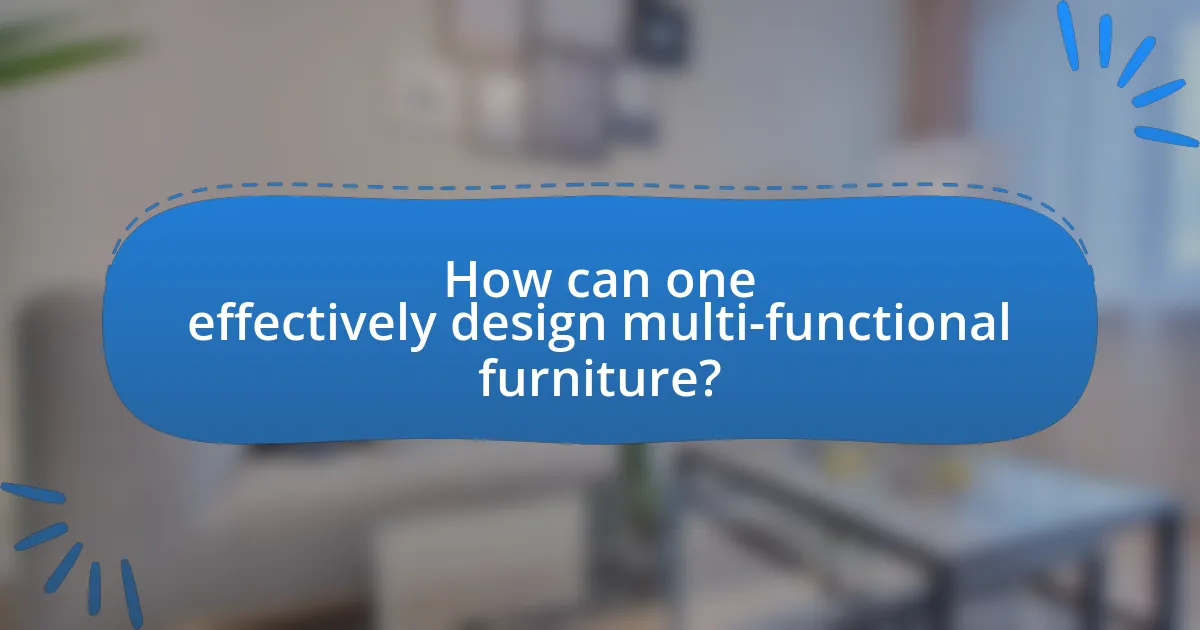Multi-functional furniture for small spaces is designed to maximize utility while minimizing the footprint, making it essential for urban living environments where space is limited. This article explores how such furniture optimizes space through adaptability and innovative design, highlighting key features like storage solutions and durability. It discusses the importance of design principles, ergonomic considerations, and aesthetic choices that enhance functionality. Additionally, the article addresses common challenges in small space furniture design and offers practical tips for selecting and assessing multi-functional pieces to improve usability and organization in compact living areas.

What is Multi-Functional Furniture for Small Spaces?
Multi-functional furniture for small spaces refers to versatile pieces designed to serve multiple purposes, maximizing utility while minimizing footprint. This type of furniture often includes items like sofa beds, extendable dining tables, and storage ottomans, which can transform a room’s functionality without requiring additional space. The effectiveness of multi-functional furniture is supported by the increasing demand for efficient living solutions in urban environments, where space is limited, and the need for adaptability is crucial.
How does multi-functional furniture optimize space?
Multi-functional furniture optimizes space by combining multiple functions into a single piece, thereby reducing the need for additional furniture. For example, a sofa bed serves as both seating and a sleeping area, effectively minimizing the footprint required for separate items. This design approach is particularly beneficial in small living environments, where every square foot counts, allowing for more efficient use of limited space. Studies indicate that incorporating multi-functional furniture can increase usable space by up to 30%, making it a practical solution for urban dwellers and those in compact homes.
What are the key features of multi-functional furniture?
Multi-functional furniture is designed to serve multiple purposes, maximizing utility in limited spaces. Key features include adaptability, where items can transform for different uses, such as a sofa that converts into a bed. Space-saving designs are crucial, often incorporating storage solutions like drawers or shelves within the furniture itself. Durability is also important, ensuring that the materials can withstand varied uses over time. Additionally, aesthetic versatility allows the furniture to blend with various interior styles, making it suitable for diverse environments. These features collectively enhance functionality while optimizing space in small living areas.
How does design influence the functionality of furniture?
Design significantly influences the functionality of furniture by determining how well it meets the needs of users in various contexts. Effective design incorporates elements such as size, shape, and material, which directly affect usability and adaptability. For instance, furniture designed with modular components can be reconfigured to serve multiple purposes, such as a sofa that transforms into a bed, thereby maximizing space efficiency in small areas. Research indicates that well-designed multi-functional furniture can increase the usability of limited spaces by up to 30%, demonstrating the critical role of design in enhancing functionality.
Why is multi-functional furniture important for small living areas?
Multi-functional furniture is important for small living areas because it maximizes space efficiency and enhances functionality. In compact environments, where every square foot counts, furniture that serves multiple purposes—such as a sofa bed or an ottoman with storage—allows residents to optimize their living space without sacrificing comfort or utility. According to a study by the American Institute of Architects, 60% of homeowners in urban areas prioritize space-saving solutions, highlighting the growing need for adaptable furniture in small living environments.
What challenges do small spaces present for furniture design?
Small spaces present significant challenges for furniture design, primarily due to limited square footage and the need for functionality. Designers must create furniture that maximizes utility while minimizing bulk, often requiring innovative solutions such as modular pieces or dual-purpose items. For instance, a study by the American Institute of Architects highlights that 60% of homeowners in urban areas prioritize space efficiency, indicating a strong demand for furniture that can adapt to various needs without overwhelming the area. Additionally, the constraints of small spaces necessitate careful consideration of scale, proportion, and layout to ensure that each piece contributes to the overall aesthetic and functionality without making the space feel cramped.
How can multi-functional furniture address these challenges?
Multi-functional furniture can effectively address the challenges of limited space by combining multiple uses into a single piece, thereby maximizing utility and minimizing clutter. For instance, a sofa bed serves as both seating and a sleeping area, allowing for efficient use of space in small living environments. According to a study by the American Institute of Architects, incorporating multi-functional furniture can increase usable space by up to 30%, making it a practical solution for urban dwellers facing space constraints. This adaptability not only enhances functionality but also promotes a more organized and aesthetically pleasing living area.

What types of multi-functional furniture are available?
Multi-functional furniture includes items such as sofa beds, storage ottomans, extendable dining tables, and wall beds. These types of furniture serve multiple purposes, maximizing space efficiency in small areas. For instance, a sofa bed can function as both a seating area and a sleeping space, while a storage ottoman provides both seating and hidden storage. Extendable dining tables can adjust in size to accommodate more guests, and wall beds can be folded away when not in use, freeing up floor space. These designs are particularly beneficial in urban living environments where space is limited.
How do different designs serve multiple purposes?
Different designs serve multiple purposes by integrating functionality and aesthetics to maximize utility in limited spaces. For instance, a sofa bed combines seating and sleeping arrangements, allowing a single piece of furniture to fulfill two roles, which is essential in small living areas. Additionally, modular furniture can be reconfigured to adapt to various needs, such as transforming a coffee table into a dining table, thereby enhancing versatility. Research indicates that multi-functional furniture can save up to 30% of space in urban apartments, demonstrating its effectiveness in optimizing living environments.
What are examples of convertible furniture pieces?
Examples of convertible furniture pieces include sofa beds, which transform from a couch into a bed, and extendable dining tables, which can be adjusted in size to accommodate more guests. Additionally, ottomans with storage capabilities can serve as seating or a coffee table while providing hidden storage. These pieces are designed to maximize functionality in limited spaces, making them ideal for small living environments.
How do storage solutions integrate with multi-functional designs?
Storage solutions integrate with multi-functional designs by providing efficient space utilization and enhancing functionality within limited areas. For instance, furniture pieces like ottomans with hidden compartments or beds with built-in drawers serve dual purposes, allowing users to maximize storage while maintaining aesthetic appeal. Research indicates that incorporating storage into multi-functional furniture can reduce clutter and improve organization, which is particularly beneficial in small living spaces where every square foot counts.
What materials are commonly used in multi-functional furniture?
Common materials used in multi-functional furniture include wood, metal, plastic, and upholstery fabrics. Wood is favored for its durability and aesthetic appeal, often used in frames and surfaces. Metal provides strength and a modern look, commonly found in legs and structural components. Plastic is lightweight and versatile, frequently utilized in modular designs. Upholstery fabrics enhance comfort and style, used in seating and convertible elements. These materials are chosen for their ability to balance functionality, durability, and design, making them ideal for space-saving solutions in small living areas.
How do material choices affect durability and aesthetics?
Material choices significantly influence both durability and aesthetics in furniture design. Durable materials, such as hardwood or metal, enhance the longevity of furniture, making it resistant to wear and tear, while aesthetically pleasing materials, like fabric or glass, contribute to the visual appeal and style of the piece. For instance, studies show that hardwood furniture can last for generations, while synthetic materials may degrade faster, impacting both functionality and appearance over time. Additionally, the texture and color of materials can create different visual impressions, affecting how a space feels and looks. Therefore, selecting the right materials is crucial for achieving a balance between durability and aesthetic value in multi-functional furniture designed for small spaces.
What sustainable options are available for eco-friendly designs?
Sustainable options for eco-friendly designs in multi-functional furniture include using reclaimed wood, recycled materials, and non-toxic finishes. Reclaimed wood reduces the demand for new lumber, thereby conserving forests and minimizing waste. Recycled materials, such as metal and plastic, help divert waste from landfills and reduce the carbon footprint associated with manufacturing new products. Non-toxic finishes ensure that harmful chemicals do not leach into the environment, promoting healthier indoor air quality. These practices not only contribute to environmental sustainability but also enhance the aesthetic and functional value of furniture designed for small spaces.

How can one effectively design multi-functional furniture?
To effectively design multi-functional furniture, one should prioritize versatility, space efficiency, and user needs. This involves creating pieces that serve multiple purposes, such as a sofa that converts into a bed or a coffee table that doubles as storage. Research indicates that incorporating modular designs allows for adaptability in various settings, which is crucial in small spaces where every square foot counts. For instance, a study by the American Institute of Architects highlights that multi-functional furniture can reduce clutter and enhance usability, making it an essential element in modern interior design.
What design principles should be considered?
Key design principles for multi-functional furniture in small spaces include functionality, adaptability, space efficiency, and aesthetics. Functionality ensures that each piece serves multiple purposes, such as a sofa that converts into a bed. Adaptability allows furniture to be reconfigured or adjusted to meet changing needs, like extendable tables. Space efficiency focuses on maximizing usable area, often through compact designs or built-in storage solutions. Aesthetics ensure that the furniture complements the overall decor, making small spaces feel inviting and cohesive. These principles are essential for creating practical and visually appealing solutions in limited areas.
How does ergonomics play a role in furniture design?
Ergonomics significantly influences furniture design by ensuring that furniture promotes comfort, efficiency, and safety for users. This discipline focuses on creating furniture that aligns with human anatomy and behavior, which is crucial in small spaces where functionality is paramount. For instance, ergonomic chairs are designed to support the natural curvature of the spine, reducing the risk of musculoskeletal disorders, which is particularly important in compact living environments where users may spend extended periods seated. Research indicates that ergonomic design can enhance productivity and well-being; a study published in the Journal of Occupational Health Psychology found that ergonomic interventions can lead to a 25% increase in productivity. Thus, integrating ergonomic principles in furniture design not only maximizes space utility but also improves user health and comfort.
What aesthetic considerations enhance functionality?
Aesthetic considerations that enhance functionality in multi-functional furniture for small spaces include simplicity, color harmony, and material selection. Simplicity in design reduces visual clutter, making spaces feel larger and more organized, which is crucial in small environments. Color harmony ensures that furniture complements the overall decor, creating a cohesive look that can make a space feel more inviting and functional. Additionally, the choice of materials affects both durability and aesthetics; for example, lightweight yet sturdy materials can facilitate easy movement and adaptability, enhancing the overall usability of the furniture. These considerations are supported by design principles that emphasize the importance of visual appeal in promoting effective use of space.
What are the common mistakes to avoid in designing multi-functional furniture?
Common mistakes to avoid in designing multi-functional furniture include neglecting user needs, compromising on comfort, and failing to ensure durability. Designers often overlook the specific requirements of users, leading to furniture that does not meet practical needs. For instance, a sofa bed may look appealing but can be uncomfortable for sleeping if not designed with adequate support. Additionally, using low-quality materials can result in furniture that wears out quickly, undermining its intended functionality. According to a study by the Furniture Industry Research Association, 70% of consumers prioritize comfort and durability in multi-functional designs, highlighting the importance of these factors in successful furniture design.
How can poor design choices impact usability?
Poor design choices can significantly hinder usability by creating confusion and frustration for users. For instance, if multi-functional furniture lacks intuitive mechanisms for transformation, users may struggle to operate it effectively, leading to a negative experience. Research indicates that 70% of users abandon products due to poor usability, highlighting the critical importance of design in facilitating user interaction. Additionally, ergonomic miscalculations can result in discomfort, further diminishing the functionality of the furniture. Therefore, thoughtful design is essential to ensure that users can easily and effectively utilize multi-functional furniture in small spaces.
What are the pitfalls of prioritizing style over function?
Prioritizing style over function in designing multi-functional furniture for small spaces can lead to several pitfalls, including reduced usability and practicality. When aesthetics dominate the design process, the resulting furniture may lack essential features that enhance its functionality, making it less effective for everyday use. For instance, a beautifully designed chair may not provide adequate support or comfort, leading to user dissatisfaction. Additionally, focusing solely on style can result in furniture that does not fit well within the limited space, causing clutter and inefficiency. Research indicates that functional design significantly impacts user satisfaction and space optimization, highlighting the importance of balancing style with practicality in furniture design.
What tips can help in selecting multi-functional furniture for small spaces?
To select multi-functional furniture for small spaces, prioritize pieces that serve multiple purposes, such as a sofa bed or an ottoman with storage. These types of furniture maximize utility while minimizing space usage. Additionally, consider modular designs that can be rearranged or expanded as needed, allowing for flexibility in layout. Look for items that are lightweight and easy to move, facilitating quick changes to the room’s configuration. Finally, ensure that the furniture complements the existing decor to maintain a cohesive aesthetic, which can enhance the overall feel of the space.
How can one assess the space requirements for furniture?
To assess the space requirements for furniture, one should measure the dimensions of the intended area and consider the size and layout of the furniture pieces. Accurate measurements of the room, including length, width, and height, provide a baseline for determining how much space is available. Additionally, it is essential to account for pathways and clearance around furniture to ensure functionality and comfort. For instance, the National Kitchen and Bath Association recommends a minimum of 36 inches of clearance for walkways in kitchens to facilitate movement. By combining these measurements with the dimensions of the furniture, one can effectively evaluate whether the pieces will fit and function well within the designated space.
What features should be prioritized for maximum utility?
The features that should be prioritized for maximum utility in designing multi-functional furniture for small spaces include adaptability, storage capacity, and ease of use. Adaptability allows furniture to serve multiple purposes, such as a sofa that converts into a bed, maximizing functionality in limited space. Storage capacity is crucial, as integrated storage solutions, like drawers or shelves, help to minimize clutter and optimize organization. Ease of use ensures that the furniture can be easily transformed or accessed, enhancing user experience and practicality. These features collectively contribute to creating efficient and versatile living environments in small spaces.


